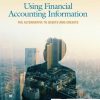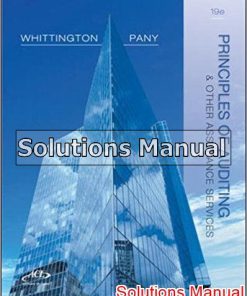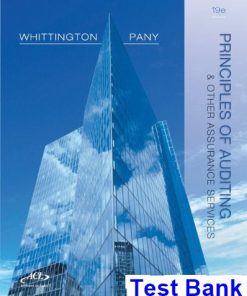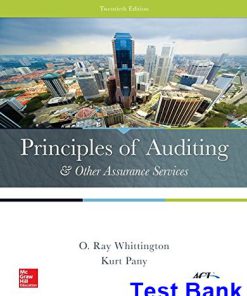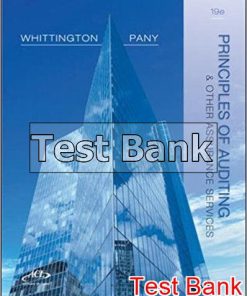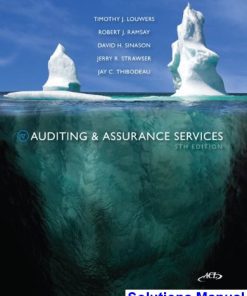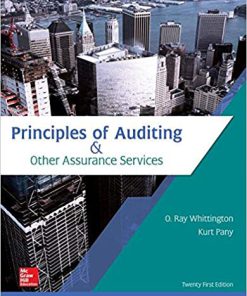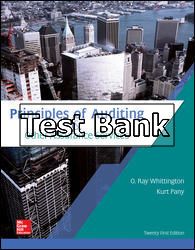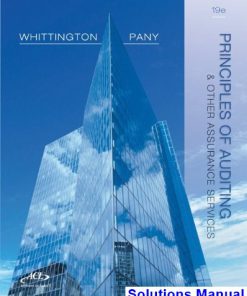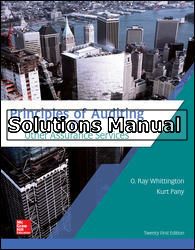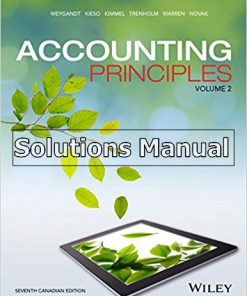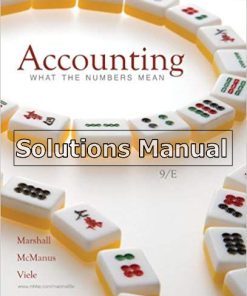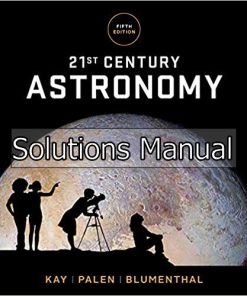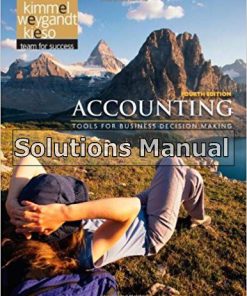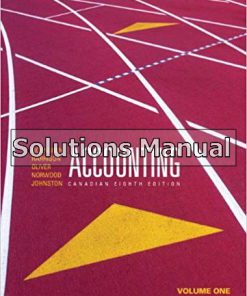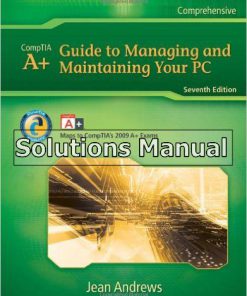Principles of Auditing and Other Assurance Services 20th Edition Whittington Solutions Manual
$50.00 Original price was: $50.00.$26.50Current price is: $26.50.
Principles of Auditing and Other Assurance Services 20th Edition Whittington Solutions Manual.
This is completed downloadable of Principles of Auditing and Other Assurance Services 20th Edition Whittington Solutions Manual
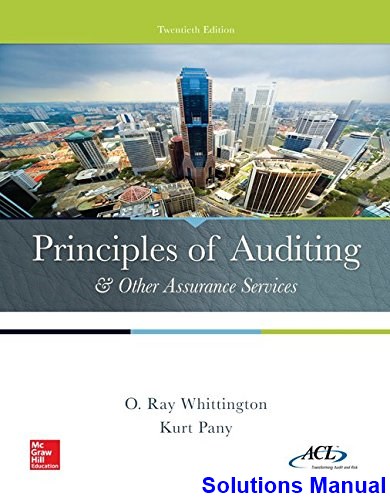
Product Details:
- ISBN-10 : 1260247953
- ISBN-13 : 978-1260247954
- Author: Ray Whittington, Kurt Pany
The 22nd edition of Principles of Auditing & Other Assurance Services provides a carefully balanced presentation of auditing theory and practice. Written in a clear and understandable manner, it is particularly appropriate for students who have had limited or no audit experience. The approach is to integrate auditing material with that of previous accounting financial, managerial, and systems courses.
Table of Content:
Chapter 1 The Role of the Public Accountant in the American Economy 1 What Are Assurance Services? 2 The Attest Function 2 Assurance and Nonassurance Services 4 Financial Statement Audits 5 What Creates the Demand for Audits? 6 Major Auditing Developments of the 20th Century 8 The Accounting Profession?s Credibility Crisis 9 Types of Audits 10 Types of Auditors 11 The Public Accounting Profession 12 American Institute of Certified Public Accountants 12 The CPA Examination 14 State Boards of Accountancy 15 Financial Accounting Standards Board 15 Governmental Accounting Standards Board 15 Federal Accounting Standards Advisory Board 15 The Public Company Accounting Oversight Board 15 Securities and Exchange Commission 16 Other Types of Professional Services 16 Organization of the Public Accounting Profession 18 Industry Specialization 19 Responsibilities of the Professional Staff 19 Professional Development for Public Accounting Firm Personnel 21 Seasonal Fluctuations in Public Accounting Work 21 Relationships with Clients 21 Chapter Summary 22 Key Terms Introduced or Emphasized in Chapter 1 23 Review Questions 24 Questions Requiring Analysis 24 Multiple Choice Questions 25 Problems 27 In-Class Team Case 29 Research and Discussion Case 29 Suggested References 29 Chapter 2 Professional Standards 31 Auditing Standards for Public and Nonpublic Companies 32 AICPA Generally Accepted Auditing Standards (GAAS) 32 General Standards?Auditor Qualifications and Quality of Work 33 Standards of Fieldwork?Accumulating and Evaluating Evidence 33 Standards of Reporting 35 AICPA Statements on Auditing Standards (SASs) 35 The Auditors? Responsibility for Detecting Misstatements 37 Errors and Fraud 37 Illegal Acts by Clients 37 The Auditors? Reports 38 The Introductory Paragraph of the Auditors? Report 38 The Scope Paragraph of the Auditors? Report 40 The Opinion Paragraph of the Auditors? Report 40 Other Types of Auditors? Reports 43 Public Company Audit Reports 43 The Attestation Standards 44 Quality Control in CPA Firms 46 Regulation of Accounting Firms 46 Public Company Accounting Oversight Board 46 Peer Review and Inspections 47 International Accounting and Auditing Standards 48 Chapter Summary 49 Key Terms Introduced or Emphasized in Chapter 2 50 Review Questions 51 Questions Requiring Analysis 52 Multiple Choice Questions 53 Problems 54 In-Class Team Case 57 Research and Discussion Case 57 Suggested References 58 Chapter 3 Professional Ethics 59 The Nature of Ethics 60 What Are Ethical Dilemmas? 60 A Framework for Ethical Decisions 60 Making Ethical Decisions?A Professional Example 61 The Need for Professional Ethics 63 Professional Ethics in Public Accounting 64 The AICPA Code of Professional Conduct 64 Analysis of Independence 67 Analysis of Integrity and Objectivity 76 Analysis of General Standards 76 Analysis of Compliance with Standards 76 Analysis of Accounting Principles 77 Analysis of Confidential Client Information 78 Analysis of Contingent Fees 79 Analysis of Acts Discreditable 80 Analysis of Advertising and Other Forms of Solicitation 80 Analysis of Commissions and Referral Fees 81 Analysis of Form of Organization and Name 81 Alternative Practice Structures 81 The CPA as Tax Advisor?Ethical Problems 82 Enforcement of Professional Ethics 83 Ethics for Internal Auditors 83 Chapter Summary 85 Key Terms Introduced or Emphasized in Chapter 3 86 Review Questions 87 Questions Requiring Analysis 88 Multiple Choice Questions 89 Problems 91 In-Class Team Cases 94 Research and Discussion Case 95 Suggested References 95 Chapter 4 Legal Liability of CPAs 97 The Scope of CPA Liability 98 Litigation Placed in Perspective 98 Sources of CPA Liability 98 CPAs? Liability to Their Clients under Common Law 100 The Elements of Duty and Breach of Duty 101 The Element of Losses (Damages) 101 The Element of Causation (Proximate Cause) 101 Auditors? Common Law Liability to Third Parties 102 Ultramares (Known User) Approach 103 Restatement of Torts (Foreseen User) Approach 103 Rosenblum (Foreseeable User) Approach 104 Summary of Third-Party Liability Approaches 104 Liability to Third Parties under Statutory Law 105 Securities Act of 1933 105 Securities Exchange Act of 1934 106 Comparison of the 1933 and 1934 Acts 108 Racketeer Influenced and Corrupt Organizations Act 108 Auditors? Criminal Liability under the Securities Acts 109 Criminal Liability under Other Statutes 110 SEC and Public Company Accounting Oversight Board Regulation 110 CPAs? Liability for Accounting and Review Services 111 CPAs?Posture in the Age of Litigation 112 Chapter Summary 113 Key Terms Introduced or Emphasized in Chapter 4 114 Review Questions 115 Questions Requiring Analysis 116 Multiple Choice Questions 119 Problems 120 In-Class Team Case 123 Research and Discussion Case 124 Suggested References 124 Chapter 5 Audit Evidence and Documentation 125 The Relationship of Audit Risk to Audit Evidence 126 Financial Statement Assertions 126 Audit Risk at the Assertion Level 127 Audit Risk Illustrated 129 Measuring Audit Risk 129 Audit Evidence 130 Types of Audit Evidence 131 Audit Procedures 137 Nature of Substantive Audit Procedures 137 Timing of Substantive Audit Procedures 137 Extent of Substantive Audit Procedures 138 Cost of Audit Procedures 139 Analytical Procedures 139 Nature of Analytical Procedures 139 Timing of Analytical Procedures 142 Extent of Analytical Procedures 143 Audit Evidence for Subjective Areas 143 Evidence on Accounting Estimates 143 Evidence on Fair Market Values 144 Evidence on Related Party Transactions 145 Audit Documentation 145 Confidential Nature of Working Papers 146 Ownership of Audit Working Papers 147 Working Papers and Auditors? Liability 147 Types of Working Papers 148 Organization of Working Papers 150 Guidelines for Preparation of Working Papers 151 Computer-Generated Working Papers 152 Review of Audit Working Papers 152 Chapter Summary 154 Key Terms Introduced or Emphasized in Chapter 5 155 Review Questions 156 Questions Requiring Analysis 157 Multiple Choice Questions 160 Problems 161 In-Class Team Case 167 Research and Discussion Cases 167 Suggested References 168 Chapter 6 Planning the Audit; Linking Audit Procedures to Risk 169 Obtaining Clients 170 Submitting a Proposal 171 Communication with Predecessor Auditors 172 First-Year Procedures 173 Use of the Client?s Staff 173 Other CPAs 174 Arranging for Specialists 174 Engagement Letters 174 Audit Planning 174 Obtaining an Understanding of the Client?s Business and Its Environment 175 Sources of Information 177 Developing an Overall Audit Strategy 179 Audit Risk 183 Assessing Inherent Risks 184 Addressing the Risks of Material Misstatement Due to Fraud 184 Responding to Risks of Material Misstatement 187 Documenting the Audit Planning Process and Risk Assessments 188 Linking Audit Procedures to Risks 189 The Audit Trail 190 Transaction Cycles (Classes of Transactions) 191 Organization of the Audit Program 191 Objectives of Audit Programs 194 General Objectives of Audit Programs for Assets 194 Substantiation of Account Balances 196 An Illustration of Audit Program Design 197 Audit Process 199 Timing of Audit Work 201 Chapter Summary 201 Key Terms Introduced or Emphasized in Chapter 6 202 Review Questions 203 Questions Requiring Analysis 204 Multiple Choice Questions 206 Problems 207 Ethics Case 209 Appendix 6A Selected Internet Addresses 210 Appendix 6B Examples of Fraud Risk Factors 210 Appendix 6C Illustrative Audit Case: Keystone Computers & Networks, Inc. 213 Part I: Audit Planning 213 Appendix 6C Problems 221 Chapter 7 Internal Control 223 The Meaning of Internal Control 224 The Foreign Corrupt Practices Act of 1977 225 Means of Achieving Internal Control 226 The Control Environment 227 Integrity and Ethical Values 227 Commitment to Competence 227 Board of Directors or Audit Committee 227 Management Philosophy and Operating Style 227 Organizational Structure 228 Assignment of Authority and Responsibility 229 Human Resource Policies and Procedures 230 Risk Assessment 230 The Accounting Information System 231 Control Activities 231 Performance Reviews 231 Information Processing Controls 232 Physical Controls 232 Segregation of Duties 233 Monitoring of Controls 234 Limitations of Internal Control 234 Enterprise Risk Management 234 The Auditors? Consideration of Internal Control 235 Obtaining an Understanding of Internal Control to Plan the Audit 236 The Control Environment 236 Risk Assessment 236 The Accounting Information System 236 Control Activities 237 Monitoring of Controls 238 Sources of Information about Internal Control 238 Documenting the Understanding of Internal Control 238 Assessing Control Risk 242 Determining the Planned Assessed Level of Control Risk and Designing Additional Tests of Controls and the Planned Substantive Tests 243 Performing Additional Tests of Controls 243 Reassessing Control Risk and Modifying Planned Substantive Tests 244 Documenting Information on the Assessed Level of Control Risk 245 Decision Aids for Audit Program Modification 245 Consideration of the Work of Internal Auditors 245 Communication of Control-Related Matters 248 Internal Control Reporting by Public Companies and Their Auditors 249 Overall Approach for an Audit of Internal Control 251 Internal Control in the Small Company 253 Chapter Summary 254 Key Terms Introduced or Emphasized in Chapter 7 254 Review Questions 256 Questions Requiring Analysis 257 Multiple Choice Questions 259 Problems 261 In-Class Team Case 264 Appendix 7A Antifraud Programs and Control Measures 266 Chapter 8 Consideration of Internal Control in an Information Technology Environment 269 Nature of IT-Based Systems 271 Characteristics of Various Types of IT-Based Systems 271 Impact of IT on the Audit Trail 273 Internal Control in an IT Environment 275 Organizational Structure of the Information System Function 275 Computer-Based Fraud 277 Internal Auditing in an IT Environment 278 Control Activities in an IT System 278 General Control Activities 280 Application Control Activities 282 User Control Activities 283 Control in Microcomputer Systems 283 The Auditors? Consideration of Internal Control in an IT Environment 284 Obtaining an Understanding of IT-Based System Controls 284 Documenting IT-Based System Controls 284 Assessing Control Risk?Testing IT-Based System Controls 285 Substantive Testing with Computers 289 Using Audit Software: An Illustration 290 Computer Service Centers and Outsourced Computer Processing 290 Chapter Summary 292 Key Terms Introduced or Emphasized in Chapter 8 293 Review Questions 295 Questions Requiring Analysis 296 Multiple Choice Questions 296 Problems 298 In-Class Team Case 300 Chapter 9 Audit Sampling 303 Comparison of Statistical and Nonstatistical Sampling 304 Selecting a Random Sample 305 Other Methods of Sample Selection 307 Stratification 307 Types of Statistical Sampling Plans 308 Allowance for Sampling Risk (Precision) 308 Sample Size 309 Audit Sampling for Tests of Controls 309 Sampling Risk for Tests of Controls 310 Attributes Sampling 310 Determine the Objective of the Test 311 Define the Attributes and ?Deviation? Conditions 311 Define the Population 311 Specify the Risk of Assessing Control Risk Too Low and the Tolerable Deviation Rate 312 Estimate the Expected Population Deviation Rate 312 Determine the Sample Size 312 Select the Sample 314 Test the Sample Items 314 Evaluate the Sample Results 314 Document the Sampling Procedure 315 Detailed Illustration of Attributes Sampling 315 Other Statistical Attributes Sampling Approaches 317 Nonstatistical Attributes Sampling 319 Audit Sampling for Substantive Tests 319 Sampling Risk for Substantive Tests 319 Classical Variables Sampling 320 Mean-per-Unit Estimation 320 Controlling Sampling Risk 320 Determination of Sample Size 321 Evaluation of Sample Results 322 Illustration of Mean-per-Unit Estimation 322 Difference and Ratio Estimation 325 Illustration of Difference and Ratio Estimation 327 Nonstatistical Sampling for Substantive Tests 328 Illustration of Nonstatistical Sampling 328 Chapter Summary 330 Key Terms Introduced or Emphasized in Chapter 9 330 Review Questions 332 Questions Requiring Analysis 333 Multiple Choice Questions 335 Problems 336 In-Class Team Case 339 Appendix 9A Probability-Proportional-to-Size (PPS) Sampling 340 Appendix 9B Audit Risk 345 Key Terms Introduced or Emphasized in Chapter 9 Appendixes 346 Questions and Problems for Chapter 9 Appendixes 347 In-Class Team Case for Chapter 9 Appendixes 348 Integrating Problem for Chapter 9 and the Appendixes 349 Chapter 10 Cash and Financial Investments 351 Cash 352 Sources and Nature of Cash 352 The Auditors? Objectives in the Audit of Cash 352 How Much Audit Time for Cash? 352 Internal Control over Cash Transactions 353 Internal Control over Cash Receipts 353 Internal Control over Cash Disbursements 355 Audit Documentation for Cash 360 Audit of Cash 360 Interim Audit Work on Cash 372 Financial Investments 372 The Need for Specialized Knowledge 372 The Auditors? Objectives in Examination of Financial Investments 373 Internal Control over Financial Investments 373 Internal Control Questionnaire 374 Audit Program for Financial Investments 374 Inherent Risks of Financial Investments 375 Substantive Tests for Financial Investments 375 Chapter Summary 379 Key Terms Introduced or Emphasized in Chapter 10 380 Review Questions 380 Questions Requiring Analysis 382 Multiple Choice Questions 384 Problems 385 In-Class Team Case 389 Research and Discussion Case 389 Ethics Case 390 CPA Simulation 390 Suggested References 395 Chapter 11 Accounts Receivable, Notes Receivable, and Revenue 397 Receivables 398 Sources and Nature of Accounts Receivable 398 Sources and Nature of Notes Receivable 398 The Auditors? Objectives in Auditing Receivables and Revenue 398 Internal Control of Accounts Receivable and Revenue 399 Control Environment 399 Risk Assessment 399 Monitoring 399 Revenue Cycle?Accounting System and Control Activities 400 Internal Control over Notes Receivable 403 Audit Documentation for Receivables and Revenue 405 Audit of Receivables and Revenue 406 Interim Audit Work on Receivables and Revenue 426 Chapter Summary 427 Key Terms Introduced or Emphasized in Chapter 11 428 Review Questions 428 Questions Requiring Analysis 429 Multiple Choice Questions 431 Problems 433 In-Class Team Case 437 Ethics Cases 439 CPA Simulation 440 Appendix 11A Illustrative Audit Case: Keystone Computers & Networks, Inc. 441 Part II: Consideration of Internal Control 441 Appendix 11A Problems 455 Appendix 11B Illustrative Audit Case: Keystone Computers & Networks, Inc. 456 Part III: Substantive Tests?Accounts Receivable and Revenue 456 Appendix 11B Problems 461 Chapter 12 Inventories and Cost of Goods Sold 463 Sources and Nature of Inventories and Cost of Goods Sold 464 The Auditors?Approach to Auditing Inventories and Cost of Goods Sold 464 Internal Control over Inventories and Cost of Goods Sold 465 Control Environment 465 Risk Assessment 466 Monitoring 466 Purchases and Production Cycles?Accounting Systems and Control Activities 466 Audit Documentation for Inventories and Cost of Goods Sold 470 Audit of Inventories and Cost of Goods Sold 470 Problems Associated with Inventory of First-Year Audit Clients 487 Chapter Summary 488 Key Terms Introduced or Emphasized in Chapter 12 488 Review Questions 489 Questions Requiring Analysis 490 Multiple Choice Questions 492 Problems 493 In-Class Team Case 497 Ethics Case 498 Research and Discussion Case 498 CPA Simulation 498 Suggested References 500 Chapter 13 Property, Plant, and Equipment: Depreciation and Depletion 501 The Auditors?Approach to Auditing Property, Plant, and Equipment 502 Contrast with Audit of Current Assets 502 Internal Control over Plant and Equipment 503 Audit Documentation 504 Initial Audits and Repeat Engagements 504 Audit of Property, Plant, and Equipment 504 Depreciation 513 The Auditors?Perspective toward Depreciation 513 The Auditors? Objectives in Auditing Depreciation 513 Audit Program?Depreciation Expense and Accumulated Depreciation 513 Testing the Client?s Provision for Depreciation 514 Examination of Natural Resources 514 Examination of Intangible Assets 515 Examination of Plant, Equipment, and Intangibles in Advance of the Balance Sheet Date 516 Chapter Summary 516 KeyTerms Introduced or Emphasized in Chapter 13 516 Review Questions 516 Questions Requiring Analysis 517 Multiple Choice Questions 519 Problems 520 In-Class Team Case 524 Chapter 14 Accounts Payable and Other Liabilities 527 Accounts Payable 528 Sources and Nature of Accounts Payable 528 The Auditors?Approach to Auditing Accounts Payable 528 Internal Control over Accounts Payable 529 Audit Documentation for Accounts Payable 530 Audit Program 531 Other Liabilities 541 Amounts Withheld from Employees?Pay 542 Sales Taxes Payable 542 Unclaimed Wages 542 Customers? Deposits 542 Accrued Liabilities 542 Balance Sheet Presentation 546 Time of Examination 546 Chapter Summary 546 Key Terms Introduced or Emphasized in Chapter 14 547 Review Questions 547 Questions Requiring Analysis 548 Multiple Choice Questions 549 Problems 551 In-Class Team Case 553 CPA Simulation 554 Appendix 14A Illustrative Audit Case: Keystone Computers & Networks, Inc. 556 Part IV: Consideration of Internal Control 556 Appendix 14A Problems 559 Chapter 15 Debt and Equity Capital 561 Interest-Bearing Debt 562 Sources and Nature of Interest-Bearing Debt 562 The Auditors?Approach to Auditing Interest-Bearing Debt 562 Assessment of the Inherent Risks Related to Interest-Bearing Debt 562 Internal Control over Interest-Bearing Debt 563 Audit Documentation 563 Audit of Interest-Bearing Debt 564 Time of Examination?Interest-Bearing Debt 569 Equity Capital 570 Sources and Nature of Owners? Equity 570 The Auditors?Approach to Auditing Owners? Equity 570 Internal Control over Owners? Equity 570 Audit Documentation for Owners? Equity 572 Audit Program?Capital Stock 572 Retained Earnings and Dividends 575 Financial Statement Presentation of Stockholders? Equity 576 Time of Examination?Stockholders? Equity 576 Audit of Partnerships and Sole Proprietorships 576 Chapter Summary 577 Key Terms Introduced or Emphasized in Chapter 15 577 Review Questions 578 Questions Requiring Analysis 579 Multiple Choice Questions 580 Problems 582 In-Class Team Case 584 Chapter 16 Auditing Operations and Completing the Audit 587 Auditing Operations 588 The Auditors?Approach to Examining Operations 588 Revenue 589 Relationship of Revenue to Balance Sheet Accounts 589 Miscellaneous Revenue 589 Expenses 589 Relationship of Expenses to Balance Sheet Accounts 590 Substantive Tests for Selling, General, and Administrative Expenses 590 The Audit of Payroll 593 Internal Control over Payroll 593 Documentation of Internal Control for Payroll 595 Audit Program for Payroll 595 Audit of the Statement of Cash Flows 596 Completing the Audit 597 Search for Unrecorded Liabilities 597 Review the Minutes of Meetings 597 Perform Final Analytical Procedures 597 Perform Procedures to Identify Loss Contingencies 597 Perform the Review for Subsequent Events 601 Obtain Representation Letter 604 Evaluate Audit Findings 604 Review the Engagement 607 Responsibilities for Other Information in the Financial Report 608 Opinion Formulation and Report Issuance 609 Communicate with the Audit Committee 609 Post-Audit Responsibilities 609 The Auditors? Subsequent Discovery of Facts Existing at the Date of Their Report 609 Subsequent Discovery of Omitted Audit Procedures 610 Chapter Summary 610 KeyTerms Introduced or Emphasized in Chapter 16 611 Review Questions 611 Questions Requiring Analysis 612 Multiple Choice Questions 614 Problems 615 In-Class Team Case 620 Research and Discussion Case 621 Suggested References 621 Chapter 17 Auditors? Reports 623 Financial Statements 624 Financial Statement Disclosures 624 Comparative Financial Statements 625 The Auditors? Standard Report?Nonpublic Clients 625 The Auditors? Standard Report?Public Clients 626 Expression of an Opinion 627 The Unqualified Opinion 628 Qualified Opinions 632 Adverse Opinions 635 Disclaimer of Opinion 635 Summary of Auditors? Reports 637 Two or More Report Modifications 637 Different Opinions on Different Statements 637 Reporting on Comparative Financial Statements 637 Reports to the SEC 640 Chapter Summary 640 KeyTerms Introduced or Emphasized in Chapter 17 641 Review Questions 641 Questions Requiring Analysis 642 Multiple Choice Questions 643 Problems 645 In-Class Team Cases 652 Research and Discussion Case 654 Suggested References 655 Chapter 18 Integrated Audits of Public Companies 657 Overview 658 Management?s Responsibility for Internal Control 658 Management?s Assessment and Evaluation Process 659 The Auditors? Responsibility for Reporting on Internal Control in PCAOB Audits 663 Plan the Engagement 663 Evaluate Management?s Assessment Process 665 Obtain an Understanding of Internal Control over Financial Reporting 665 Test and Evaluate Design Effectiveness of Internal Control over Financial Reporting 670 Test and Evaluate Operating Effectiveness of Internal Control over Financial Reporting 670 Form an Opinion on the Effectiveness of Internal Control over Financial Reporting 674 Audit Report Modifications 677 Other Communication Requirements 678 Chapter Summary 680 KeyTerms Introduced or Emphasized in Chapter 18 680 Review Questions 681 Questions Requiring Analysis 682 Multiple Choice Questions 682 Problems 684 In-Class Team Case 685 Chapter 19 Additional Assurance Services: Historical Financial Information 687 Special Reports 688 Financial Statements Prepared for Use in Other Countries 692 Audits of Personal Financial Statements 692 Reviews of the Interim Information of Public Companies 693 Review Services for Nonpublic Companies 696 Accountants? Reports on Comparative Statements 699 Letters for Underwriters 700 Condensed Financial Statements 700 Accounting Services 700 Compilation Engagements for Financial Statements of Nonpublic Companies 701 Other ?Association? with the Financial Statements of Public Companies 703 Chapter Summary 703 Key Terms Introduced or Emphasized in Chapter 19 704 Review Questions 704 Questions Requiring Analysis 705 Multiple Choice Questions 706 Problems 708 In-Class Team Case 711 Research and Discussion Case 712 Suggested References 712 Chapter 20 Additional Assurance Services: Other Information 713 Assurance Services 714 The Demand for Assurance Services 715 Attestation Standards 716 The Criteria 717 Attestation Risk and Materiality 719 The Character of the Engagement 719 Assurance Service Examples 722 Assurance on Internal Control over Financial Reporting 722 Assurance on Prospective Financial Statements 724 Assurance on Compliance 725 Assurance on Management?s Discussion and Analysis 725 Trust Services 726 ElderCare/PrimePlus Services 728 CPA Performance View 729 CPA Risk Advisory Services 729 Future Assurance Services 729 Chapter Summary 730 Key Terms Introduced or Emphasized in Chapter 20 730 Review Questions 731 Questions Requiring Analysis 732 Multiple Choice Questions 733 Problems 735 In-Class Team Case 736 Research and Discussion Case 736 Chapter 21 Internal, Operational, and Compliance Auditing 737 Internal Auditing 738 What Is the Purpose of Internal Auditing? 738 Evolution of Internal Auditing 738 The Internal Auditors? Role in Sarbanes-Oxley Compliance 739 Professional Standards of Internal Auditing 740 Certification of Internal Auditors 744 Operational Auditing 744 Objectives of Operational Audits 744 General Approach to Operational Audits 745 Compliance Auditing 748 Attesting to Compliance with Laws and Regulations 748 Compliance Auditing of Government Entities and Organizations Receiving Federal Financial Assistance 750 Compliance Auditing?A Summary 757 Chapter Summary 758 Key Terms Introduced or Emphasized in Chapter 21 759 Review Questions 760 Questions Requiring Analysis 760 Multiple Choice Questions 762 Problems 763 In-Class Team Case 764 Index 765
People Also Search:
principles of auditing and other assurance services 20th edition
principles of auditing and other assurance services
principles of auditing and other assurance services 20th edition download scribd
principles of auditing and other assurance services 20th edition solution manual download pdf
Instant download after Payment is complete
You may also like…
Solutions Manual
Principles of Auditing Other Assurance Services 19th Edition Whittington Solutions Manual
Accounting
Principles of Auditing and Other Assurance Services 19th Edition Whittington Solutions Manual
Solutions Manual
Principles of Auditing Other Assurance Services 21st Edition Whittington Solutions Manual
Related products
Solutions Manual
Solutions Manual
Solutions Manual
Accounting Volume 1 Canadian 8th Edition Horngren Solutions Manual
Solutions Manual


